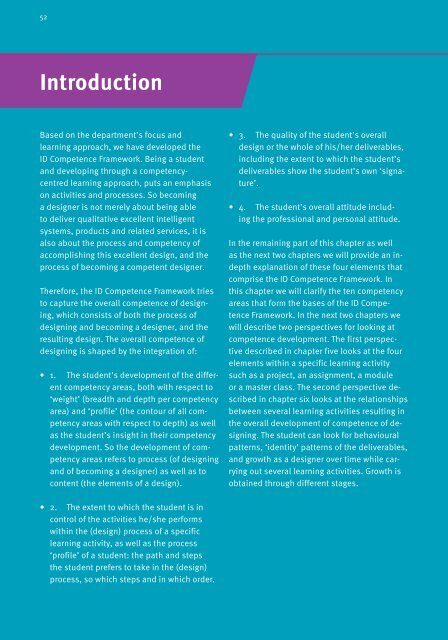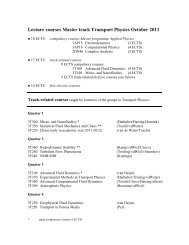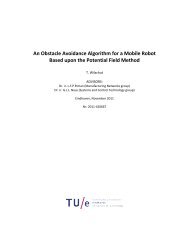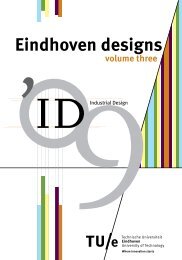Education guide 'Eindhoven designs' - Technische Universiteit ...
Education guide 'Eindhoven designs' - Technische Universiteit ...
Education guide 'Eindhoven designs' - Technische Universiteit ...
You also want an ePaper? Increase the reach of your titles
YUMPU automatically turns print PDFs into web optimized ePapers that Google loves.
52<br />
Introduction<br />
Based on the department’s focus and<br />
learning approach, we have developed the<br />
ID Competence Framework. Being a student<br />
and developing through a competencycentred<br />
learning approach, puts an emphasis<br />
on activities and processes. So becoming<br />
a designer is not merely about being able<br />
to deliver qualitative excellent intelligent<br />
systems, products and related services, it is<br />
also about the process and competency of<br />
accomplishing this excellent design, and the<br />
process of becoming a competent designer.<br />
Therefore, the ID Competence Framework tries<br />
to capture the overall competence of designing,<br />
which consists of both the process of<br />
designing and becoming a designer, and the<br />
resulting design. The overall competence of<br />
designing is shaped by the integration of:<br />
• 1. The student’s development of the different<br />
competency areas, both with respect to<br />
‘weight’ (breadth and depth per competency<br />
area) and ‘profile’ (the contour of all competency<br />
areas with respect to depth) as well<br />
as the student’s insight in their competency<br />
development. So the development of competency<br />
areas refers to process (of designing<br />
and of becoming a designer) as well as to<br />
content (the elements of a design).<br />
• 3. The quality of the student’s overall<br />
design or the whole of his/her deliverables,<br />
including the extent to which the student’s<br />
deliverables show the student’s own ‘signature’.<br />
• 4. The student’s overall attitude including<br />
the professional and personal attitude.<br />
In the remaining part of this chapter as well<br />
as the next two chapters we will provide an indepth<br />
explanation of these four elements that<br />
comprise the ID Competence Framework. In<br />
this chapter we will clarify the ten competency<br />
areas that form the bases of the ID Competence<br />
Framework. In the next two chapters we<br />
will describe two perspectives for looking at<br />
competence development. The first perspective<br />
described in chapter five looks at the four<br />
elements within a specific learning activity<br />
such as a project, an assignment, a module<br />
or a master class. The second perspective described<br />
in chapter six looks at the relationships<br />
between several learning activities resulting in<br />
the overall development of competence of designing.<br />
The student can look for behavioural<br />
patterns, ‘identity’ patterns of the deliverables,<br />
and growth as a designer over time while carrying<br />
out several learning activities. Growth is<br />
obtained through different stages.<br />
• 2. The extent to which the student is in<br />
control of the activities he/she performs<br />
within the (design) process of a specific<br />
learning activity, as well as the process<br />
‘profile’ of a student: the path and steps<br />
the student prefers to take in the (design)<br />
process, so which steps and in which order.

















